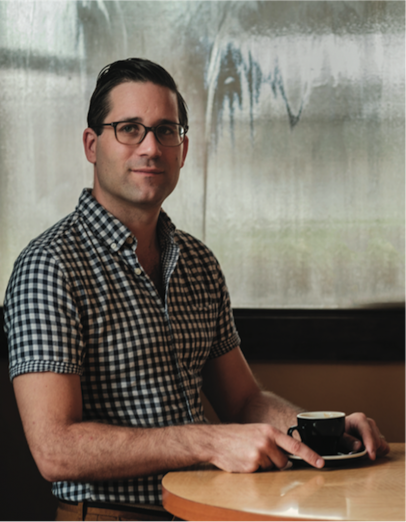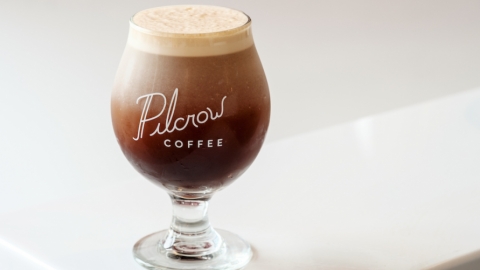Coffee Break: Comfort
What is coffee if not comfortable? Warm, familiar, aromatic; the beverage seems imbued with an almost Proustian ability to transport the drinker. But then I had to admit, perhaps coffee has gotten a little more complicated over the years. On a cool and rainy moring, I headed to the Milwaukee Public Market in pursit of what is, for me, a style of coffee brewing and a style of service that typifies comfortable coffee.
Now out of fashion, french press coffee service in prior decades was commonly seen in specialty coffee shops across the county. The metal filter of the press allows for sediment and oils to pass into the brew, resulting in a dense, rich style of coffee that pairs well with roasty, balanced, sweet and nutty coffees.
Frech press is also an ideal way to showcase the ritual and process of coffee brewing. That quotidian yet essential act of preparing and sharing coffee is too often lost, yet remains on display at Anodyne in the Public Market.
With the solitude of the Market behind me (Anodyne is open several hours earlier than the other Market shops), morning sunlight reflected upon a swirling, garnet-colored brew which smelled of date sugar and plum. Frech press coffee has a hefty mouthfeel, almost like unfiltered beer, but should not be gritty. A hint of sediment seems to settle on the palate and then wash away. My cup, the La Cieba from Guatemala, was a complex array of caramel and cereal notes, with mellow citrus and cherry acidity, finishing with date, fig, plum and vanilla.
While a french press brew seems to touch on the raw, homelike side of coffee, for me, the genesis of comfort in coffee is milk. Milk harmonizes with coffee to create a beverage that is richer and easy to drink. Milk mellows the acidity in coffee, and due to its protein content, lends itself well to the creation of foam. In barista lingo, using the espresso machine to foam milk is called "steaming." Milk steaming is not an art, but it does take practice; when done well, it creates a microfoam with a texture that is full but fluffy, like whipped cream with less fat content.
This sweet, luscious foam is the feature of the classic modern espresso drink: the cappuccino. The cappuccino took root during the evolution of espresso machines during the early 20th century and is generally made from one part espresso and two parts steamed milk--a ratio that gives plenty of room for the flavor of the coffee to articulate itself while allowing rich foam and butterfat to balance the intensity of espresso. With over a decade of educating baristas, I'll say that mastery over the cappuccino is a rare thing.
For a quintessential cappuccino experience, make sure you order your drink in a ceramic or porcelain cup. When served, a nice, crisp ring of brown milk should encircle the cup, ensuring coffee with every sip. A great cappuccino should be hot, but not overly so, an almost-gooey affair that begs enjoyment in a dozen or so slurps. Although, if you are so inclined to let your cappuccino hang out for a while, here's a pro tip: take the small spoon on our saucer and stir that foam back into the drink.
For a cozy cappuccino experience, check out Colectivo at the Lake this autumn. With Milwaukee sunrises starting after 7:00 a.m., there's ample time to order a drink and pull up a chair to watch. Using less espresso than other cappuccinos and just 2% milk, Colectivo's cap offers a near-delicate experience, driven by silky foam and notes of breakfast tea, butterscotch and brown butter.
One of the best cappuccinos in town can be found at Anodyne. If you can catch veteran barista Alex Schwalbach at their Bay View or Tosa locations, you would be entirely remiss not to order one. In a pleasantly weighty black and white porcelain, this eight ounce cappuccino uses as its base an espresso blend of Colombian, Guatemalan and Brazilian coffees. The natural-processed Brazilian lends a berry-like quality to the blend, a flavor which asserts itself in the back half of the drink. Upfront, look for cereal and caramel notes with righteous, pillowy foam and a meringue-like aroma. Finishing with notes of craisin and black currant, almost like a fruit beer, Anodyne's cappuccino is an experience anyone can enjoy.
For a smaller dose of comfort, order a cortado. This compact drink's popularity exploded in the last two years. In Spain and other countries, drinks served as a cortado can vary--in the U.S., the standard cortado has become a 4-ounce drink made from equal parts espresso and steamed milk, served on the cooler side. The cortado epitomizes the modern coffee movement: difficult to make well, easy-to-drink, strongly coffee-forward and very fun. When you order a cortado, you may be offered a choice of espresso... hear your barista out, and consider the options; 50 cents more may get you an espresso with cleaner and more dynamic flavors.
With half the cup being espresso, one should expect a strong coffee drink with the glossy finish that comes from expertly steamed milk. This fun and cuddly drink is mostly served in a glass on a saucer, with a spoon for adding sugar.
In our chaotic world, I hope that this autumn you can find a quick moment for a warm, flavorful coffee and find a bit of comfort as well.






